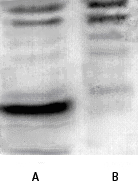聯(lián)系我們
電 話:0771-2310996
傳 真:0771-2310995
E-mail : 735565094@qq.com
技術(shù)支持E-mail: immunechem@gmail.com 備案號(hào):桂ICP備09007987號(hào)
地 址:廣西南寧市高新技術(shù)開發(fā)區(qū)科園大道68號(hào)東盟慧谷11棟203室 530007
|
Catalog# Product Description |
ICP0381 Affinity purified rabbit polyclonal anti-acetylated lysine antibody (anti-AcK) was developed using a unique technique that utilizes acetylated KLH as the immunogen. The purified antibody was conjugated to horseradish peroxidase (HRP) via reductive amination. Direct labelling of the primary antibody will avoid the use of secondary antibodies therefore eliminating the interference of the secondary antibody-conjugates. |
|

Western blot analysis of acetylated histone from TSA-treated (A) and non-treated melanoma cell lysates (B) with ICP0381.
|
|
Species
|
Rabbit
|
||
|
Formulation
|
250 μg/mL antibody in stabilizing buffer with 50% glycerol
|
||
|
Immunogen
|
Acetylated KLH conjugates
|
||
|
Purification
|
The antibody was purified on acetyl-lysine agarose.
|
||
|
Conjugation
|
Reductive amination; HRP/Ab molar ratio - 10:1
|
||
|
Specificity
|
The antibody recognizes proteins acetylated on lysine residues. Tested: acetylated histone, acetylated BSA, and acetylated MBP; there was no reaction to the non-acetylated proteins.
|
||
|
Applications
|
For direct immunofluorescence experiments
|
||
|
Scientific Description
|
DNA transcription cannot take place unless DNA is unwound from the nucleosomes. The cell unwinds the DNA by acetylating the lysine residues within the proteins. It has been suggested that acetylation of non-histone proteins (e.g. transcription factors) and histones may be involved. Acetylation of the proteins may result in signal transduction within the chromatic domains.
|
||
|
Storage & Stability
|
Product is stable for several weeks at 4°C. For extended storage, store product at -20°C. Expiration date is six months from date of shipping if stored properly.
|
||
|
Product Specific References |
|